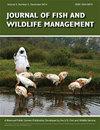Striped Bass Morone saxatilis movement in a large southeastern river system
IF 0.9
4区 环境科学与生态学
Q4 BIODIVERSITY CONSERVATION
引用次数: 0
Abstract
Striped Bass Morone saxatilis are a valuable commercial and recreation fishery resource and fill important ecological roles within an ecosystem. Migratory behaviors of coastal Striped Bass are diverse and vary by latitude along the US Atlantic coast. Northern populations are anadromous, with spawning occurring in tidal freshwater/brackish rivers and adults leave spawning locations during the winter to conduct north-south coastal migrations. Southern populations (below Cape Hatteras, NC) are typically resident and potamodromous, completing full life cycles within river systems, and do not migrate along the Atlantic coast. The objective of this study was to describe daily movement patterns and centers of attraction (e.g., spawning and resting stages) of Striped Bass in the Great Pee Dee River, South Carolina. Ten fish were implanted with hydroacoustic transmitters between 2013 and 2016. Daily movement and behavior are described using the state-space model with a two-dimensional spatial coordinate system. A total of 94,857 data points were recorded across all individuals and receivers. Two movement patterns were observed. One group completed a seasonal migration (i.e., were recorded swimming upstream or downstream) that coincides with spring spawning season. A second group was present in the lower river section and Winyah Bay during the winter for three consecutive years but were never observed migrating up the Great Pee Dee River during the spring. One individual was documented swimming 80 river km north in the Atlantic Intracoastal Waterway, suggesting there are important overwintering locations outside their natal river. Additionally, there were significant gaps in observations for all individuals, particularly in the summer. It is possible fish are leaving the main stem in search of thermal refuge within small tributaries. Identifying these overwintering areas and tributaries that serve as summer refuge is needed to determine stressors and fishing pressure of this important species.东南部一个大型河流水系中的带鱼(Morone saxatilis)活动情况
斑马鱼是一种宝贵的商业和休闲渔业资源,在生态系统中扮演着重要的生态角色。沿美国大西洋沿岸,条纹鲈鱼的迁徙行为多种多样,且随纬度的变化而变化。北方种群是溯河产卵,在潮汐淡水/咸淡水河流中产卵,成鱼在冬季离开产卵地点进行南北沿海迁徙。南部种群(北卡罗来纳州哈特拉斯角以下)是典型的常住和穴居,在河流系统中完成完整的生命周期,并且不沿大西洋海岸迁移。本研究的目的是描述南卡罗来纳州大皮迪河条纹鲈鱼的日常运动模式和吸引中心(如产卵和休息阶段)。2013年至2016年期间,10条鱼被植入了水声发射器。日常运动和行为用二维空间坐标系下的状态空间模型来描述。在所有个体和接受者中共记录了94,857个数据点。观察到两种运动模式。其中一组完成了季节性迁徙(即,被记录向上游或下游游),与春季产卵季节相吻合。第二组在冬季连续三年出现在下游河段和温耶湾,但在春季从未观察到它们向大皮迪河上游迁移。有记录显示,其中一只在大西洋沿岸内水道向北游了80公里,这表明在它们的出生河流之外还有重要的越冬地点。此外,所有个体的观测结果都存在显著差距,特别是在夏季。有可能鱼类正在离开主干,在小支流中寻找热避难所。确定这些越冬区和作为夏季避难所的支流是确定这一重要物种的压力源和捕捞压力的必要条件。
本文章由计算机程序翻译,如有差异,请以英文原文为准。
求助全文
约1分钟内获得全文
求助全文
来源期刊

Journal of Fish and Wildlife Management
BIODIVERSITY CONSERVATION-ECOLOGY
CiteScore
1.60
自引率
0.00%
发文量
43
审稿时长
>12 weeks
期刊介绍:
Journal of Fish and Wildlife Management encourages submission of original, high quality, English-language scientific papers on the practical application and integration of science to conservation and management of native North American fish, wildlife, plants and their habitats in the following categories: Articles, Notes, Surveys and Issues and Perspectives. Papers that do not relate directly to native North American fish, wildlife plants or their habitats may be considered if they highlight species that are closely related to, or conservation issues that are germane to, those in North America.
 求助内容:
求助内容: 应助结果提醒方式:
应助结果提醒方式:


